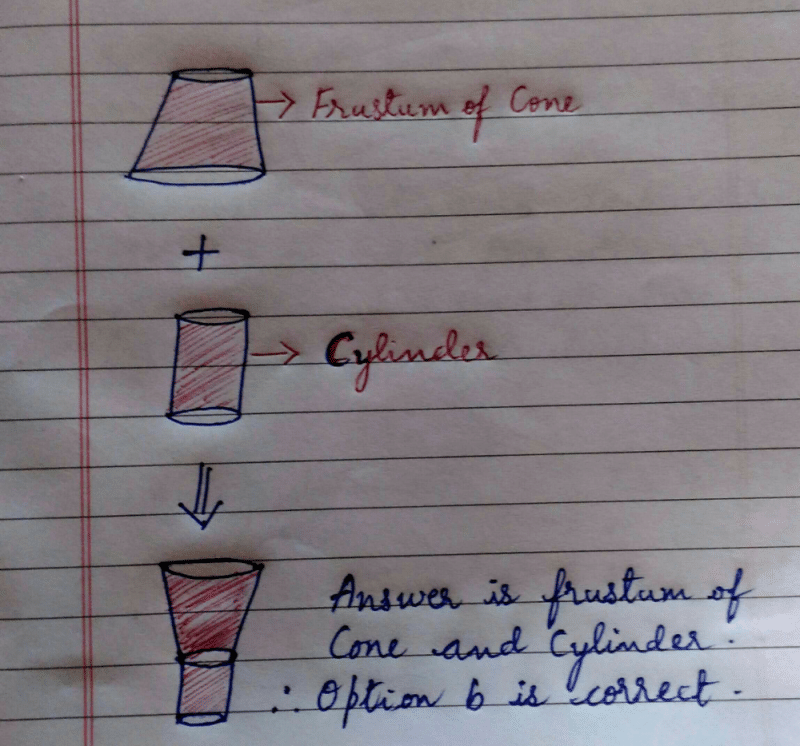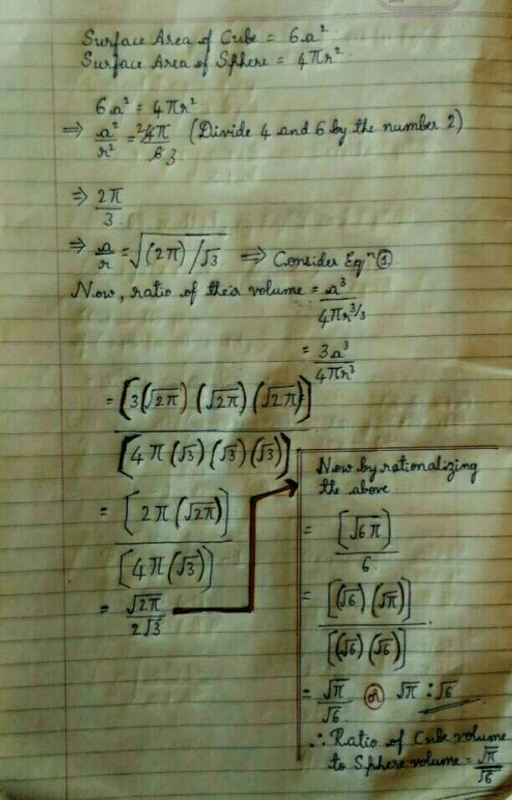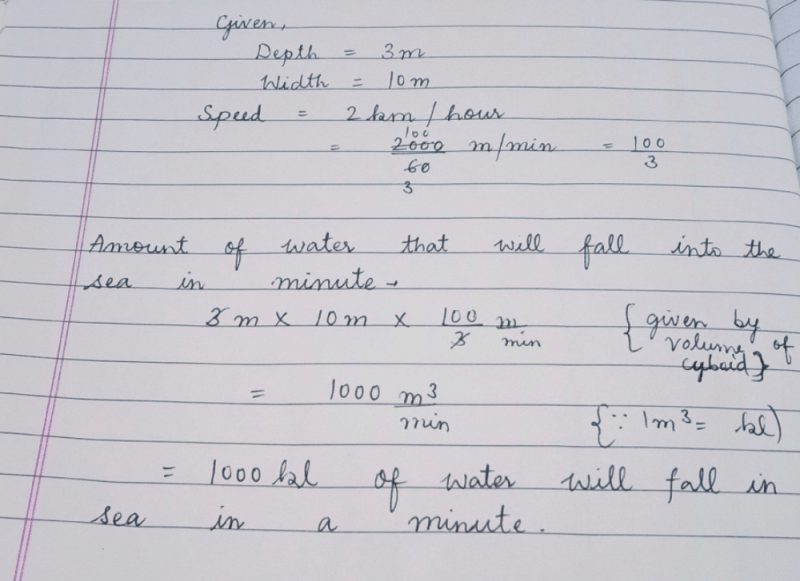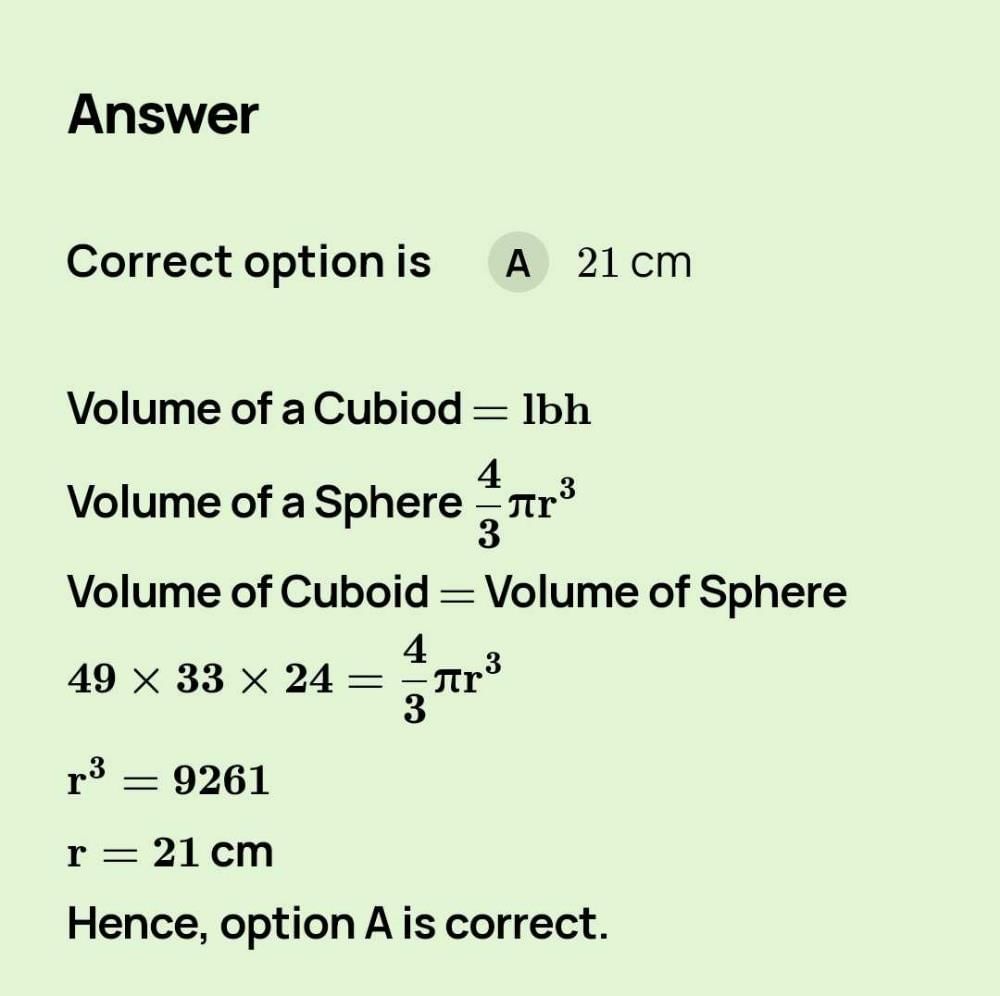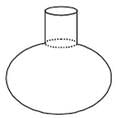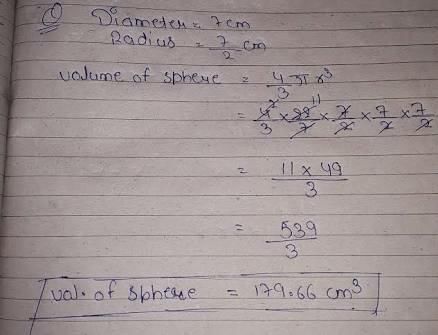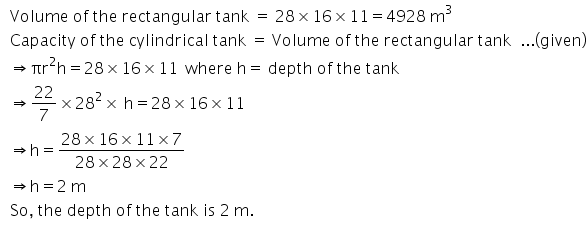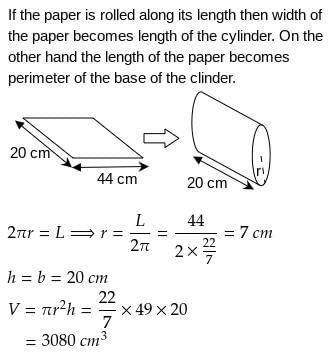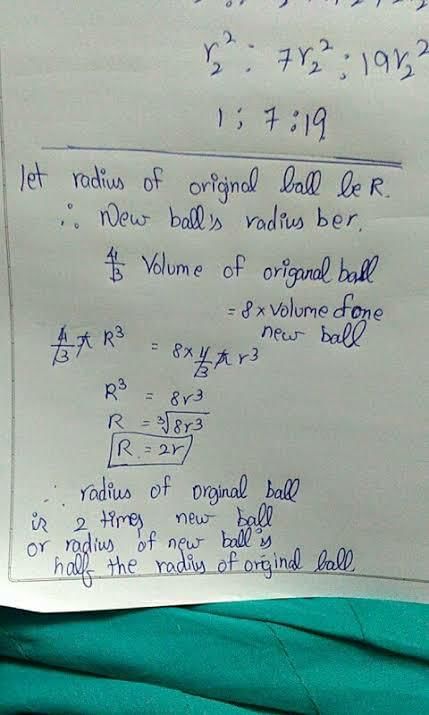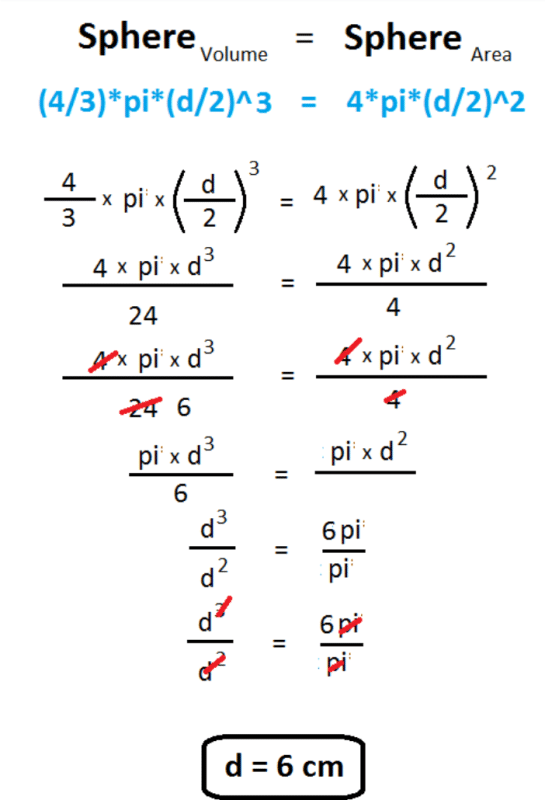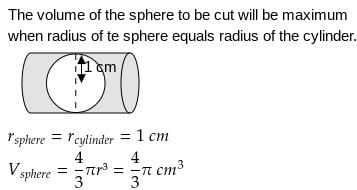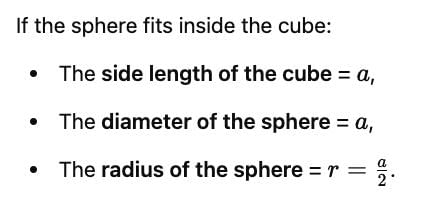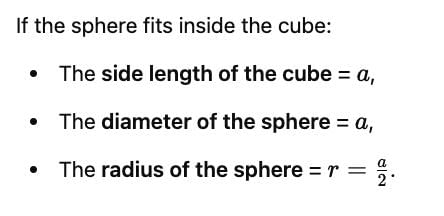All Exams >
Class 10 >
Mathematics (Maths) Class 10 >
All Questions
All questions of Surface Areas and Volumes for Class 10 Exam
If a marble of radius 2.1 cm is put into a cylindrical cup full of water of radius 5 cm and height 6 cm, then how much water flows out of the cylindricall cup?
- a)38.8 cm3
- b)55.4 cm3
- c)19.4 cm3
- d)471.4 cm3
Correct answer is option 'A'. Can you explain this answer?
If a marble of radius 2.1 cm is put into a cylindrical cup full of water of radius 5 cm and height 6 cm, then how much water flows out of the cylindricall cup?
a)
38.8 cm3
b)
55.4 cm3
c)
19.4 cm3
d)
471.4 cm3

|
Imk Pathshala answered |
Given, a marble of radius 2.1 cm is put into a cylindrical cup full of water of radius 5 cm and height 6 cm.
We have to find the quantity of water that flows out of the cylindrical cup.
We know that when the marble is put inside the cylindrical cup full of water the volume of water displaced is equal to the volume of the marble.
So, volume of water that flows out = volume of the marble
Volume of sphere = (4/3)πr3
Given, radius = 2.1 cm
So, volume of marble = (4/3)(22/7)(2.1)3
= 38.808 cm³
Therefore, the volume of the water that flows out is 38.8 cm³
The volume of the largest right circular cone that can be cut out from a cube of edge 4.2 cm is- a)9.7 cm3
- b)77.6 cm3
- c)58.2 cm3
- d)19.4 cm3
Correct answer is option 'D'. Can you explain this answer?
The volume of the largest right circular cone that can be cut out from a cube of edge 4.2 cm is
a)
9.7 cm3
b)
77.6 cm3
c)
58.2 cm3
d)
19.4 cm3

|
Rajeev Malik answered |
The volume of the largest right circular cone that can be cut out from a cube of edge 4.2 cm is 19.404 cm^3.
Edge of the cube = 4.2 cm
i.e 2r = 4.2
r = 4.2/2 = 2.1 cm
h = 4.2 cm
Volume of the cone = 1/3 * pi * r^2 * h
=> 1/3 * 22/7 * 2.1 * 2.1 * 4.2
=> 19.404 cm^3
Hence, the volume of the largest right circular cone that can be cut out from a cube of edge 4.2 cm is 19.404 cm^3.
A container is in the form of a hemispherical bowl mounted by a hollow cylinder. The diameter of the sphere is 24 cm and the total height of the container is 16 cm. Its capacity is- a)5390.60 cm3
- b)5100 cm3
- c)5400 cm3
- d)5425.92 cm3
Correct answer is option 'D'. Can you explain this answer?
A container is in the form of a hemispherical bowl mounted by a hollow cylinder. The diameter of the sphere is 24 cm and the total height of the container is 16 cm. Its capacity is
a)
5390.60 cm3
b)
5100 cm3
c)
5400 cm3
d)
5425.92 cm3
|
|
Meghana shah answered |
To find the capacity of the container, we need to calculate the volume of the hemispherical bowl and the volume of the cylinder separately, and then add them together.
Given:
Diameter of the sphere = 24 cm
Total height of the container = 16 cm
**Calculating the Volume of the Hemispherical Bowl:**
The radius of the sphere (r) can be calculated by dividing the diameter by 2.
r = 24 cm / 2 = 12 cm
The volume of a hemisphere is given by the formula:
V_hemisphere = (2/3) * π * r^3
Substituting the value of r, we get:
V_hemisphere = (2/3) * π * 12^3
Calculating this value, we find:
V_hemisphere ≈ 3617.92 cm^3
**Calculating the Volume of the Cylinder:**
The height of the cylinder can be calculated by subtracting the radius of the sphere from the total height of the container.
Height of the cylinder = Total height of the container - Radius of the sphere
Height of the cylinder = 16 cm - 12 cm = 4 cm
The radius of the cylinder is the same as the radius of the sphere, which is 12 cm.
The volume of a cylinder is given by the formula:
V_cylinder = π * r^2 * h
Substituting the values of r and h, we get:
V_cylinder = π * 12^2 * 4
Calculating this value, we find:
V_cylinder ≈ 1809.28 cm^3
**Calculating the Total Capacity:**
The total capacity of the container is the sum of the volume of the hemisphere and the volume of the cylinder.
Total capacity = V_hemisphere + V_cylinder
Total capacity ≈ 3617.92 cm^3 + 1809.28 cm^3
Calculating this value, we find:
Total capacity ≈ 5427.20 cm^3
Rounding off to two decimal places, we get:
Total capacity ≈ 5425.92 cm^3
Therefore, the correct answer is option D) 5425.92 cm^3.
Given:
Diameter of the sphere = 24 cm
Total height of the container = 16 cm
**Calculating the Volume of the Hemispherical Bowl:**
The radius of the sphere (r) can be calculated by dividing the diameter by 2.
r = 24 cm / 2 = 12 cm
The volume of a hemisphere is given by the formula:
V_hemisphere = (2/3) * π * r^3
Substituting the value of r, we get:
V_hemisphere = (2/3) * π * 12^3
Calculating this value, we find:
V_hemisphere ≈ 3617.92 cm^3
**Calculating the Volume of the Cylinder:**
The height of the cylinder can be calculated by subtracting the radius of the sphere from the total height of the container.
Height of the cylinder = Total height of the container - Radius of the sphere
Height of the cylinder = 16 cm - 12 cm = 4 cm
The radius of the cylinder is the same as the radius of the sphere, which is 12 cm.
The volume of a cylinder is given by the formula:
V_cylinder = π * r^2 * h
Substituting the values of r and h, we get:
V_cylinder = π * 12^2 * 4
Calculating this value, we find:
V_cylinder ≈ 1809.28 cm^3
**Calculating the Total Capacity:**
The total capacity of the container is the sum of the volume of the hemisphere and the volume of the cylinder.
Total capacity = V_hemisphere + V_cylinder
Total capacity ≈ 3617.92 cm^3 + 1809.28 cm^3
Calculating this value, we find:
Total capacity ≈ 5427.20 cm^3
Rounding off to two decimal places, we get:
Total capacity ≈ 5425.92 cm^3
Therefore, the correct answer is option D) 5425.92 cm^3.
The radius (in cm) of the largest right circular cone that can be cut out from a cube of edge 4.2 cm is - a)4.2
- b)2.1
- c)8.1
- d)1.05
Correct answer is option 'B'. Can you explain this answer?
The radius (in cm) of the largest right circular cone that can be cut out from a cube of edge 4.2 cm is
a)
4.2
b)
2.1
c)
8.1
d)
1.05
|
|
Abhi Prajapati answered |
Diameter of cone = edge of cube.
2r =4.1
r = 4.1/2
r = 2.1 cm
Hence radius of cone is equal to 2.1cm
2r =4.1
r = 4.1/2
r = 2.1 cm
Hence radius of cone is equal to 2.1cm
A cone and a cylinder have their heights in the ratio 4: 5 and their diameters are in the ratio 3: 2. The ratio of their volumes will be- a)6: 7
- b)4: 3
- c)3: 5
- d)5: 3
Correct answer is option 'C'. Can you explain this answer?
A cone and a cylinder have their heights in the ratio 4: 5 and their diameters are in the ratio 3: 2. The ratio of their volumes will be
a)
6: 7
b)
4: 3
c)
3: 5
d)
5: 3
|
|
Ananya Das answered |
Height of cone =4x
Height of cylinder=5x
Diameter of cone=3y
Diameter of cylinder=2y
Volume of cone= Volume of cylinder= πr2h=y2*5x
Volume of cylinder= πr2h=y2*5x

Height of cylinder=5x
Diameter of cone=3y
Diameter of cylinder=2y
Volume of cone=
 Volume of cylinder= πr2h=y2*5x
Volume of cylinder= πr2h=y2*5x
A medicine-capsule is in the shape of a cylinder of diameter 0.5 cm with two hemispheres stuck to each of its ends. The length of entire capsule is 2 cm. The capacity of the capsule is- a)0.36 cm3
- b)0.35 cm3
- c)0.34 cm3
- d)0.33 cm3
Correct answer is option 'A'. Can you explain this answer?
A medicine-capsule is in the shape of a cylinder of diameter 0.5 cm with two hemispheres stuck to each of its ends. The length of entire capsule is 2 cm. The capacity of the capsule is
a)
0.36 cm3
b)
0.35 cm3
c)
0.34 cm3
d)
0.33 cm3
|
|
Apoorva kulkarni answered |
Understanding the Capsule Shape
The capsule consists of a cylindrical portion with two hemispherical ends. To find the total volume of the capsule, we need to calculate the volumes of the cylinder and the two hemispheres separately.
Dimensions of the Capsule
- Diameter of the capsule = 0.5 cm
- Radius (r) = Diameter / 2 = 0.25 cm
- Length of the capsule = 2 cm
- Length of the cylindrical part = Total length - Length of two hemispheres = 2 cm - 2 * (0.25 cm) = 1.5 cm
Volume of the Cylinder
The volume V of a cylinder is given by the formula:
- V = πr²h
Where:
- r = radius of the cylinder = 0.25 cm
- h = height of the cylinder = 1.5 cm
Calculating the volume:
- V_cylinder = π * (0.25)² * 1.5 = π * 0.0625 * 1.5 = 0.296875π cm³
Volume of the Hemispheres
The volume V of a sphere is given by the formula:
- V = (4/3)πr³
Since we have two hemispheres, the volume is:
- V_hemisphere = 2 * (1/2) * (4/3)πr³ = (4/3)πr³
Calculating the volume for both hemispheres:
- V_hemispheres = (4/3)π * (0.25)³ = (4/3)π * 0.015625 = 0.0208333π cm³
Total Volume of the Capsule
Now, add the volumes of the cylinder and the hemispheres:
- Total Volume = V_cylinder + V_hemispheres
- Total Volume = 0.296875π + 0.0208333π = 0.3177083π cm³
Using π ≈ 3.14:
- Total Volume ≈ 0.3177083 * 3.14 ≈ 0.999 cm³
Since the options provided are in cubic centimeters, rounding gives:
- Total Volume ≈ 0.36 cm³
Thus, the capacity of the capsule is approximately 0.36 cm³, confirming that the correct answer is option 'A'.
The capsule consists of a cylindrical portion with two hemispherical ends. To find the total volume of the capsule, we need to calculate the volumes of the cylinder and the two hemispheres separately.
Dimensions of the Capsule
- Diameter of the capsule = 0.5 cm
- Radius (r) = Diameter / 2 = 0.25 cm
- Length of the capsule = 2 cm
- Length of the cylindrical part = Total length - Length of two hemispheres = 2 cm - 2 * (0.25 cm) = 1.5 cm
Volume of the Cylinder
The volume V of a cylinder is given by the formula:
- V = πr²h
Where:
- r = radius of the cylinder = 0.25 cm
- h = height of the cylinder = 1.5 cm
Calculating the volume:
- V_cylinder = π * (0.25)² * 1.5 = π * 0.0625 * 1.5 = 0.296875π cm³
Volume of the Hemispheres
The volume V of a sphere is given by the formula:
- V = (4/3)πr³
Since we have two hemispheres, the volume is:
- V_hemisphere = 2 * (1/2) * (4/3)πr³ = (4/3)πr³
Calculating the volume for both hemispheres:
- V_hemispheres = (4/3)π * (0.25)³ = (4/3)π * 0.015625 = 0.0208333π cm³
Total Volume of the Capsule
Now, add the volumes of the cylinder and the hemispheres:
- Total Volume = V_cylinder + V_hemispheres
- Total Volume = 0.296875π + 0.0208333π = 0.3177083π cm³
Using π ≈ 3.14:
- Total Volume ≈ 0.3177083 * 3.14 ≈ 0.999 cm³
Since the options provided are in cubic centimeters, rounding gives:
- Total Volume ≈ 0.36 cm³
Thus, the capacity of the capsule is approximately 0.36 cm³, confirming that the correct answer is option 'A'.
A cubical ice cream brick of edge 22 cm is to be distributed among some children by filling ice cream cones of radius 2 cm and height 7 cm upto its brim. How many children will get the ice cream cones?- a)163
- b)263
- c)363
- d)463
Correct answer is option 'C'. Can you explain this answer?
A cubical ice cream brick of edge 22 cm is to be distributed among some children by filling ice cream cones of radius 2 cm and height 7 cm upto its brim. How many children will get the ice cream cones?
a)
163
b)
263
c)
363
d)
463
|
|
Nature Lover answered |
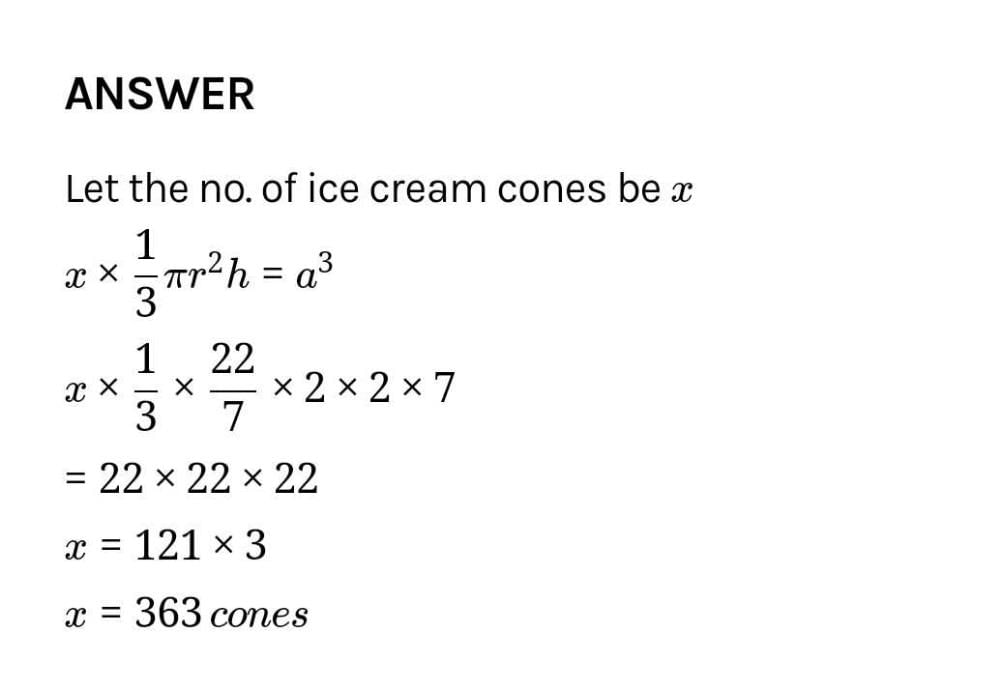
On increasing each of the radius of the base and the height of a cone by 20%. By what percent its volume will be increased?- a)72.8%
- b)60%
- c)40%
- d)30%
Correct answer is option 'A'. Can you explain this answer?
On increasing each of the radius of the base and the height of a cone by 20%. By what percent its volume will be increased?
a)
72.8%
b)
60%
c)
40%
d)
30%
|
|
Priyanka Kapoor answered |
Let the original radius be r and height be h.
Original volume = V = 1/3 πr2h
New radius = 120% of r = 120r/100 = 6r/5
New height = 120% of h = 120h/100 = 6h/5
New volume
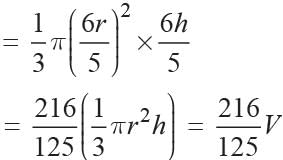
Increase in volume

Increase %
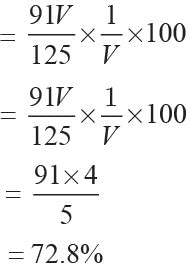
Original volume = V = 1/3 πr2h
New radius = 120% of r = 120r/100 = 6r/5
New height = 120% of h = 120h/100 = 6h/5
New volume

Increase in volume

Increase %

A cylinder, a cone and a hemisphere are of equal base and have the same height. The ratio of their volumes is
- a)4: 5: 7
- b)3: 2: 1
- c)1: 2:3
- d)3: 1: 2
Correct answer is option 'D'. Can you explain this answer?
A cylinder, a cone and a hemisphere are of equal base and have the same height. The ratio of their volumes is
a)
4: 5: 7
b)
3: 2: 1
c)
1: 2:3
d)
3: 1: 2

|
Abhishek Kumar Pandey answered |
According to me, Option D is not the right answer.....
option B is the right answer.
I am sorry because I couldn't able to attach the solution...
solution:
let r be the radius and h be the height.
so, ratio of volume of cylinder,cone& hemisphere=
πr²h: 1/3πr²h:2/3πr³
(since h=r)
=> πr³:1/3πr³:2/3πr³
=>1:1/3:2/3
=>3:1:2
your explanation.
A cylinder, a cone and a hemisphere have equal base and height. Find the ratio of their volumes- a)1:1:1
- b)2:3:1
- c)3 :1 :2
- d)1:2:3
Correct answer is option 'C'. Can you explain this answer?
A cylinder, a cone and a hemisphere have equal base and height. Find the ratio of their volumes
a)
1:1:1
b)
2:3:1
c)
3 :1 :2
d)
1:2:3
|
|
Nandini jain answered |
**Given**
- A cylinder, a cone, and a hemisphere have equal base and height.
**To Find**
- The ratio of their volumes.
**Solution**
Let's assume the height and base radius of each shape to be 'h' and 'r', respectively.
**Volume of a Cylinder**
The volume of a cylinder is given by the formula:
Vcylinder = πr^2h
**Volume of a Cone**
The volume of a cone is given by the formula:
Vcone = (1/3)πr^2h
**Volume of a Hemisphere**
The volume of a hemisphere is given by the formula:
Vhemisphere = (2/3)πr^3
**Given Conditions**
- The base radius and height of the cylinder, cone, and hemisphere are equal.
- So, r = h for all three shapes.
**Substituting Values**
Substituting r = h in the volume formulas for each shape, we get:
Vcylinder = πr^2h = πh^2h = πh^3
Vcone = (1/3)πr^2h = (1/3)πh^2h = (1/3)πh^3
Vhemisphere = (2/3)πr^3 = (2/3)πh^3
**Comparing Volumes**
The ratio of the volumes of the cylinder, cone, and hemisphere can be found by dividing each volume by the volume of the cylinder (since the cylinder has the largest volume):
Ratio = (Vcylinder : Vcone : Vhemisphere) / Vcylinder
= (πh^3 : (1/3)πh^3 : (2/3)πh^3) / πh^3
= 1 : (1/3) : (2/3)
= 3 : 1 : 2
Therefore, the ratio of their volumes is 3 : 1 : 2. The correct answer is option 'C'.
- A cylinder, a cone, and a hemisphere have equal base and height.
**To Find**
- The ratio of their volumes.
**Solution**
Let's assume the height and base radius of each shape to be 'h' and 'r', respectively.
**Volume of a Cylinder**
The volume of a cylinder is given by the formula:
Vcylinder = πr^2h
**Volume of a Cone**
The volume of a cone is given by the formula:
Vcone = (1/3)πr^2h
**Volume of a Hemisphere**
The volume of a hemisphere is given by the formula:
Vhemisphere = (2/3)πr^3
**Given Conditions**
- The base radius and height of the cylinder, cone, and hemisphere are equal.
- So, r = h for all three shapes.
**Substituting Values**
Substituting r = h in the volume formulas for each shape, we get:
Vcylinder = πr^2h = πh^2h = πh^3
Vcone = (1/3)πr^2h = (1/3)πh^2h = (1/3)πh^3
Vhemisphere = (2/3)πr^3 = (2/3)πh^3
**Comparing Volumes**
The ratio of the volumes of the cylinder, cone, and hemisphere can be found by dividing each volume by the volume of the cylinder (since the cylinder has the largest volume):
Ratio = (Vcylinder : Vcone : Vhemisphere) / Vcylinder
= (πh^3 : (1/3)πh^3 : (2/3)πh^3) / πh^3
= 1 : (1/3) : (2/3)
= 3 : 1 : 2
Therefore, the ratio of their volumes is 3 : 1 : 2. The correct answer is option 'C'.
A cylindrical tub of radius 5 cm and length 9.8 cm is full of water. A solid in the form of a right circular cone mounted on a hemisphere is immersed in the tub. If the radius of the a hemisphere is 3.5 cm and height of cone outside the hemisphere is 5 cm, find the volume of the water left in the tub.- a)200 cm3
- b)600 cm3
- c)550 cm3
- d)616 cm3
Correct answer is option 'D'. Can you explain this answer?
A cylindrical tub of radius 5 cm and length 9.8 cm is full of water. A solid in the form of a right circular cone mounted on a hemisphere is immersed in the tub. If the radius of the a hemisphere is 3.5 cm and height of cone outside the hemisphere is 5 cm, find the volume of the water left in the tub.
a)
200 cm3
b)
600 cm3
c)
550 cm3
d)
616 cm3
|
|
Rajeev Chavan answered |
Given:
Radius of cylindrical tub, r = 5 cm
Length of cylindrical tub, l = 9.8 cm
Radius of hemisphere, R = 3.5 cm
Height of cone outside the hemisphere, h = 5 cm
To find: Volume of the water left in the tub
Approach:
First, we find the total volume of the cylindrical tub.
Then, we find the volume of the solid (cone mounted on a hemisphere) that is immersed in the tub.
Finally, we subtract the volume of the solid from the total volume of the tub to get the volume of the water left in the tub.
Calculation:
1. Volume of the cylindrical tub
Given,
Radius of the cylindrical tub, r = 5 cm
Length of the cylindrical tub, l = 9.8 cm
The formula for the volume of a cylinder is:
V_cylinder = πr^2l
Substituting the given values, we get:
V_cylinder = π(5)^2(9.8) = 245π cm^3
2. Volume of the solid (cone mounted on a hemisphere)
Given,
Radius of hemisphere, R = 3.5 cm
Height of cone outside the hemisphere, h = 5 cm
The solid consists of a cone mounted on a hemisphere. We can find the volume of the solid by adding the volumes of the cone and the hemisphere.
The formula for the volume of a cone is:
V_cone = 1/3πr^2h
Substituting the given values, we get:
V_cone = 1/3π(3.5)^2(5) = 61.25π/3 cm^3
The formula for the volume of a hemisphere is:
V_hemisphere = 2/3πR^3
Substituting the given values, we get:
V_hemisphere = 2/3π(3.5)^3 = 42.875π/3 cm^3
Therefore, the volume of the solid is:
V_solid = V_cone + V_hemisphere = 61.25π/3 + 42.875π/3 = 104.125π/3 cm^3
3. Volume of the water left in the tub
The volume of the water left in the tub is the total volume of the cylindrical tub minus the volume of the solid that is immersed in the tub.
V_water = V_cylinder - V_solid
V_water = 245π - 104.125π/3
V_water = 735/3π - 104.125/3π
V_water = (735 - 104.125)/3π
V_water = 216.875/3π cm^3
V_water = 216.875/3 × 3.14
V_water = 616.06 cm^3
Therefore, the volume of the water left in the tub is 616.06 cm^3 (approximately).
Hence, the correct option is (d) 616 cm^3.
Radius of cylindrical tub, r = 5 cm
Length of cylindrical tub, l = 9.8 cm
Radius of hemisphere, R = 3.5 cm
Height of cone outside the hemisphere, h = 5 cm
To find: Volume of the water left in the tub
Approach:
First, we find the total volume of the cylindrical tub.
Then, we find the volume of the solid (cone mounted on a hemisphere) that is immersed in the tub.
Finally, we subtract the volume of the solid from the total volume of the tub to get the volume of the water left in the tub.
Calculation:
1. Volume of the cylindrical tub
Given,
Radius of the cylindrical tub, r = 5 cm
Length of the cylindrical tub, l = 9.8 cm
The formula for the volume of a cylinder is:
V_cylinder = πr^2l
Substituting the given values, we get:
V_cylinder = π(5)^2(9.8) = 245π cm^3
2. Volume of the solid (cone mounted on a hemisphere)
Given,
Radius of hemisphere, R = 3.5 cm
Height of cone outside the hemisphere, h = 5 cm
The solid consists of a cone mounted on a hemisphere. We can find the volume of the solid by adding the volumes of the cone and the hemisphere.
The formula for the volume of a cone is:
V_cone = 1/3πr^2h
Substituting the given values, we get:
V_cone = 1/3π(3.5)^2(5) = 61.25π/3 cm^3
The formula for the volume of a hemisphere is:
V_hemisphere = 2/3πR^3
Substituting the given values, we get:
V_hemisphere = 2/3π(3.5)^3 = 42.875π/3 cm^3
Therefore, the volume of the solid is:
V_solid = V_cone + V_hemisphere = 61.25π/3 + 42.875π/3 = 104.125π/3 cm^3
3. Volume of the water left in the tub
The volume of the water left in the tub is the total volume of the cylindrical tub minus the volume of the solid that is immersed in the tub.
V_water = V_cylinder - V_solid
V_water = 245π - 104.125π/3
V_water = 735/3π - 104.125/3π
V_water = (735 - 104.125)/3π
V_water = 216.875/3π cm^3
V_water = 216.875/3 × 3.14
V_water = 616.06 cm^3
Therefore, the volume of the water left in the tub is 616.06 cm^3 (approximately).
Hence, the correct option is (d) 616 cm^3.
A solid toy is in the form of a right circular cylinder with a hemispherical shape at one end and a cone at the other end. Their common diameter is 4.2 cm and the heights of the cylindrical and conical portions are 12 cm and 7 cm respectively. The approximate volume of the toy will be- a)250 cm3
- b)200 cm3
- c)300 cm3
- d)218 cm3
Correct answer is option 'D'. Can you explain this answer?
A solid toy is in the form of a right circular cylinder with a hemispherical shape at one end and a cone at the other end. Their common diameter is 4.2 cm and the heights of the cylindrical and conical portions are 12 cm and 7 cm respectively. The approximate volume of the toy will be
a)
250 cm3
b)
200 cm3
c)
300 cm3
d)
218 cm3
|
|
Cat Warior answered |
D
A cylindrical vessel of diameter 42 cm and height 40 cm contains water up to a depth of 16 cm. Now a solid iron cylinder, with diameter 14 cm and height 32 cm is placed upright in the cylindrical vessel. The volume of the water required to just submerge the solid cylinder will be- a)17, 248 cm3
- b)14, 000 cm3
- c)15, 600 cm3
- d)16, 045 cm3
Correct answer is option 'A'. Can you explain this answer?
A cylindrical vessel of diameter 42 cm and height 40 cm contains water up to a depth of 16 cm. Now a solid iron cylinder, with diameter 14 cm and height 32 cm is placed upright in the cylindrical vessel. The volume of the water required to just submerge the solid cylinder will be
a)
17, 248 cm3
b)
14, 000 cm3
c)
15, 600 cm3
d)
16, 045 cm3

|
Tanishka Gupta answered |
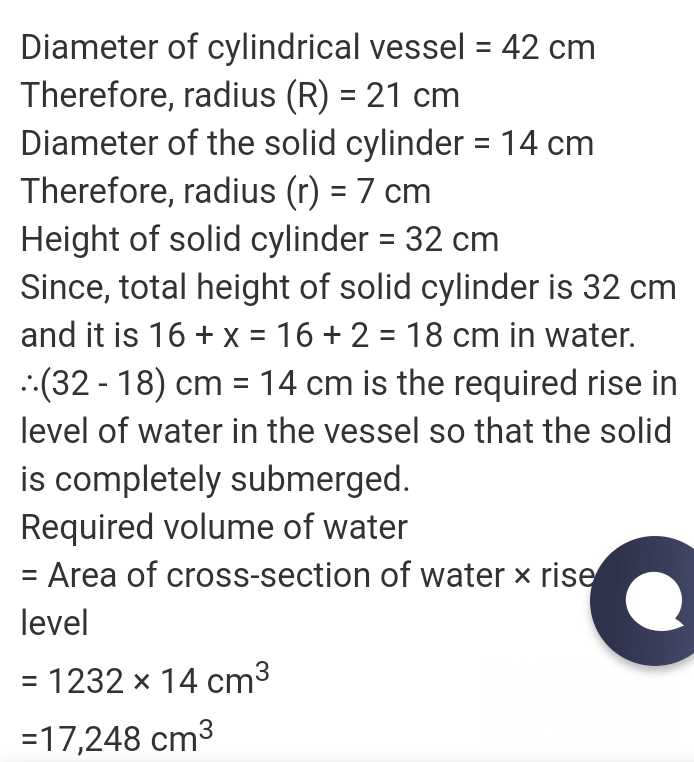
In a swimming pool measuring 90 m x 40 m, 150 men take a dip. If the average displacement of water by a man is 8 m3, then rise in water level is- a)27.33 cm
- b)30 cm
- c)31.33 cm
- d)33.33 cm
Correct answer is option 'D'. Can you explain this answer?
In a swimming pool measuring 90 m x 40 m, 150 men take a dip. If the average displacement of water by a man is 8 m3, then rise in water level is
a)
27.33 cm
b)
30 cm
c)
31.33 cm
d)
33.33 cm
|
|
Anisha kapoor answered |
Volume of water displaced = 150 x 8 = 1200 m3
⇒ 90 x 40 x h = 1200
⇒
⇒ 90 x 40 x h = 1200
⇒

A solid sphere of copper of radius 10.5 cm is melted and right cones of radius 3.5 cm and height 3 cm are made from the material. What is the number of cones made?- a)136
- b)126
- c)156
- d)146
Correct answer is option 'B'. Can you explain this answer?
A solid sphere of copper of radius 10.5 cm is melted and right cones of radius 3.5 cm and height 3 cm are made from the material. What is the number of cones made?
a)
136
b)
126
c)
156
d)
146
|
|
Amar jha answered |
To find the number of cones made, we need to determine the volume of the solid sphere and the volume of each cone. Then, we can divide the volume of the sphere by the volume of each cone to find the number of cones.
Given:
Radius of the sphere, r = 10.5 cm
Radius of the cone, R = 3.5 cm
Height of the cone, h = 3 cm
1. Find the volume of the sphere:
The volume of a sphere is given by the formula V = (4/3)πr³.
Substituting the value of the radius, we get V = (4/3)π(10.5)³.
2. Find the volume of each cone:
The volume of a cone is given by the formula V = (1/3)πR²h.
Substituting the values of the radius and height, we get V = (1/3)π(3.5)²(3).
3. Find the number of cones:
To find the number of cones, we divide the volume of the sphere by the volume of each cone:
Number of cones = (Volume of the sphere) / (Volume of each cone).
Let's calculate the values:
1. Volume of the sphere:
V = (4/3)π(10.5)³ = (4/3)π(1157.625) = 1543.5π cm³
2. Volume of each cone:
V = (1/3)π(3.5)²(3) = (1/3)π(12.25)(3) = 12.25π cm³
3. Number of cones:
Number of cones = 1543.5π / 12.25π = 126
Therefore, the number of cones made from the material is 126 cones, which corresponds to option B.
Given:
Radius of the sphere, r = 10.5 cm
Radius of the cone, R = 3.5 cm
Height of the cone, h = 3 cm
1. Find the volume of the sphere:
The volume of a sphere is given by the formula V = (4/3)πr³.
Substituting the value of the radius, we get V = (4/3)π(10.5)³.
2. Find the volume of each cone:
The volume of a cone is given by the formula V = (1/3)πR²h.
Substituting the values of the radius and height, we get V = (1/3)π(3.5)²(3).
3. Find the number of cones:
To find the number of cones, we divide the volume of the sphere by the volume of each cone:
Number of cones = (Volume of the sphere) / (Volume of each cone).
Let's calculate the values:
1. Volume of the sphere:
V = (4/3)π(10.5)³ = (4/3)π(1157.625) = 1543.5π cm³
2. Volume of each cone:
V = (1/3)π(3.5)²(3) = (1/3)π(12.25)(3) = 12.25π cm³
3. Number of cones:
Number of cones = 1543.5π / 12.25π = 126
Therefore, the number of cones made from the material is 126 cones, which corresponds to option B.
The weight of a metallic spherical shell is 11.176 kg. If the inner radius of the cell is 6 cm. 1 cm3 of the metal weights 21 g then what is the thickness of the shell?- a)1 cm
- b)2 cm
- c)3 cm
- d)4 cm
Correct answer is option 'A'. Can you explain this answer?
The weight of a metallic spherical shell is 11.176 kg. If the inner radius of the cell is 6 cm. 1 cm3 of the metal weights 21 g then what is the thickness of the shell?
a)
1 cm
b)
2 cm
c)
3 cm
d)
4 cm
|
|
Sanjula dubey answered |
To find the thickness of the metallic spherical shell, we need to use the concept of density and weight.
Given data:
- Weight of the metallic spherical shell = 11.176 kg
- Inner radius of the shell = 6 cm
- Density of the metal = 21 g/cm3
Let's solve the problem step by step:
1. Calculate the volume of the spherical shell:
The volume of a spherical shell can be calculated using the formula:
Volume = (4/3) * π * (R_outer^3 - R_inner^3)
Since the inner radius is given as 6 cm, we can assume the outer radius as R cm.
Volume = (4/3) * π * (R^3 - 6^3)
2. Calculate the weight of the metallic shell:
The weight of the metallic shell can be calculated using the formula:
Weight = Volume * Density
11.176 kg = Volume * 21 g/cm3
Now, let's convert the weight to grams:
11.176 kg = 11176 g
Therefore, Volume = 11176 g / 21 g/cm3
3. Substitute the value of Volume in the equation calculated in step 1 and solve for R:
11176 g / 21 g/cm3 = (4/3) * π * (R^3 - 6^3)
4. Simplify the equation:
(11176 g / 21 g/cm3) = (4/3) * π * (R^3 - 216)
5. Solve for R:
R^3 - 216 = (11176 g / 21 g/cm3) * (3/4π)
R^3 - 216 = 1596 g / 7 g/cm3
6. Simplify and solve for R:
R^3 = (1596 g / 7 g/cm3) + 216
R^3 = 228 g/cm3
Taking the cube root on both sides, we get:
R ≈ 6.2 cm
7. Calculate the thickness of the shell:
Thickness = R_outer - R_inner
Thickness = 6.2 cm - 6 cm
Thickness ≈ 0.2 cm
Therefore, the thickness of the metallic spherical shell is approximately 0.2 cm.
Given data:
- Weight of the metallic spherical shell = 11.176 kg
- Inner radius of the shell = 6 cm
- Density of the metal = 21 g/cm3
Let's solve the problem step by step:
1. Calculate the volume of the spherical shell:
The volume of a spherical shell can be calculated using the formula:
Volume = (4/3) * π * (R_outer^3 - R_inner^3)
Since the inner radius is given as 6 cm, we can assume the outer radius as R cm.
Volume = (4/3) * π * (R^3 - 6^3)
2. Calculate the weight of the metallic shell:
The weight of the metallic shell can be calculated using the formula:
Weight = Volume * Density
11.176 kg = Volume * 21 g/cm3
Now, let's convert the weight to grams:
11.176 kg = 11176 g
Therefore, Volume = 11176 g / 21 g/cm3
3. Substitute the value of Volume in the equation calculated in step 1 and solve for R:
11176 g / 21 g/cm3 = (4/3) * π * (R^3 - 6^3)
4. Simplify the equation:
(11176 g / 21 g/cm3) = (4/3) * π * (R^3 - 216)
5. Solve for R:
R^3 - 216 = (11176 g / 21 g/cm3) * (3/4π)
R^3 - 216 = 1596 g / 7 g/cm3
6. Simplify and solve for R:
R^3 = (1596 g / 7 g/cm3) + 216
R^3 = 228 g/cm3
Taking the cube root on both sides, we get:
R ≈ 6.2 cm
7. Calculate the thickness of the shell:
Thickness = R_outer - R_inner
Thickness = 6.2 cm - 6 cm
Thickness ≈ 0.2 cm
Therefore, the thickness of the metallic spherical shell is approximately 0.2 cm.
The volume of the cube is 1728 cm3. What is the total surface area of the cube?- a)824 cm2
- b)864 cm2
- c)924 cm2
- d)None of these
Correct answer is option 'B'. Can you explain this answer?
The volume of the cube is 1728 cm3. What is the total surface area of the cube?
a)
824 cm2
b)
864 cm2
c)
924 cm2
d)
None of these
|
|
Namrata singhania answered |
Given information:
- Volume of the cube = 1728 cm³
To find:
- Total surface area of the cube
Solution:
A cube has 6 equal square faces. Let's assume that each side of the cube has a length of 'a' cm.
Volume of the cube = a³
Given that the volume of the cube is 1728 cm³, we can write the equation as:
a³ = 1728
Taking the cube root on both sides of the equation:
a = ∛1728
a = 12 cm
Therefore, each side of the cube is 12 cm.
Total surface area of the cube can be calculated by adding the areas of all 6 square faces.
Calculating the area of one square face:
Area of a square = side × side
Area of one square face = 12 cm × 12 cm
Area of one square face = 144 cm²
Calculating the total surface area of the cube:
Total surface area = 6 × Area of one square face
Total surface area = 6 × 144 cm²
Total surface area = 864 cm²
Therefore, the total surface area of the cube is 864 cm², which corresponds to option 'B'.
- Volume of the cube = 1728 cm³
To find:
- Total surface area of the cube
Solution:
A cube has 6 equal square faces. Let's assume that each side of the cube has a length of 'a' cm.
Volume of the cube = a³
Given that the volume of the cube is 1728 cm³, we can write the equation as:
a³ = 1728
Taking the cube root on both sides of the equation:
a = ∛1728
a = 12 cm
Therefore, each side of the cube is 12 cm.
Total surface area of the cube can be calculated by adding the areas of all 6 square faces.
Calculating the area of one square face:
Area of a square = side × side
Area of one square face = 12 cm × 12 cm
Area of one square face = 144 cm²
Calculating the total surface area of the cube:
Total surface area = 6 × Area of one square face
Total surface area = 6 × 144 cm²
Total surface area = 864 cm²
Therefore, the total surface area of the cube is 864 cm², which corresponds to option 'B'.
Marbles of diameter 1.4 cm are dropped into a cylindrical beaker of diameter 7 cm containing some water. What is the number of marbles that should be dropped into the beaker so that the water level rises by 5.6 cm?- a)120
- b)130
- c)150
- d)180
Correct answer is option 'C'. Can you explain this answer?
Marbles of diameter 1.4 cm are dropped into a cylindrical beaker of diameter 7 cm containing some water. What is the number of marbles that should be dropped into the beaker so that the water level rises by 5.6 cm?
a)
120
b)
130
c)
150
d)
180
|
|
Priyanka Kapoor answered |
Let the no. of marbles = x
Radius of marble = 1.4/2 = 0.7 cm
Radius of cylinder = 7/2 = 3.5 cm
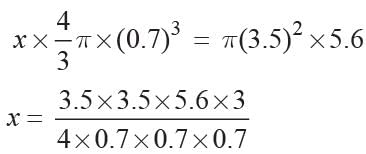
⇒ x = 150
Radius of marble = 1.4/2 = 0.7 cm
Radius of cylinder = 7/2 = 3.5 cm

⇒ x = 150
The height of a right cylinder is 165 cm and the diameter of its base is 24 cm. Find the radius of the sphere whose volume is equal to the volume of the given cylinder.- a)12 cm
- b)6 cm
- c)16 cm
- d)24 cm
Correct answer is option 'A'. Can you explain this answer?
The height of a right cylinder is 165 cm and the diameter of its base is 24 cm. Find the radius of the sphere whose volume is equal to the volume of the given cylinder.
a)
12 cm
b)
6 cm
c)
16 cm
d)
24 cm
|
|
Ritu Saxena answered |
Volume of given cylinder = πr2h
= π(12)2 × 16
Now,

= π(12)2 × 16
Now,

A solid cylinder of diameter 12 cm and height 15 cm is melted and recast into 12 toys in the shape of a right circular cone mounted on a hemisphere. Find the radius of the hemisphere, if height of the cone is 3 times the radius.- a)3 cm
- b)6 cm
- c)5 cm
- d)9 cm
Correct answer is option 'A'. Can you explain this answer?
A solid cylinder of diameter 12 cm and height 15 cm is melted and recast into 12 toys in the shape of a right circular cone mounted on a hemisphere. Find the radius of the hemisphere, if height of the cone is 3 times the radius.
a)
3 cm
b)
6 cm
c)
5 cm
d)
9 cm
|
|
Ritu Saxena answered |
Radius of cylinder = 12/2 = 6 cm
height = 15 cm
Volume of cylinder = πr2h
= 22/7 x 62 x 15
= 540π cm3
Volume of 12 toys = 540π cm3
Volume of 1 toy = 540π/12 = 45π cm3
Let the radius of the hemisphere be r cm.
Height of the cone = 3r cm
Volume of one toy = Volume of hemisphere + volume of cone

Now

height = 15 cm
Volume of cylinder = πr2h
= 22/7 x 62 x 15
= 540π cm3
Volume of 12 toys = 540π cm3
Volume of 1 toy = 540π/12 = 45π cm3
Let the radius of the hemisphere be r cm.
Height of the cone = 3r cm
Volume of one toy = Volume of hemisphere + volume of cone

Now

The radii of two cylinders are in the ratio 2 : 3 and their heights are in the ratio 5 : 3. What is the ratio of their volumes?- a)20 : 27
- b)27 : 20
- c)9 : 4
- d)4 : 9
Correct answer is option 'A'. Can you explain this answer?
The radii of two cylinders are in the ratio 2 : 3 and their heights are in the ratio 5 : 3. What is the ratio of their volumes?
a)
20 : 27
b)
27 : 20
c)
9 : 4
d)
4 : 9
|
|
Priyanka Kapoor answered |
Let the radii of two cylinders are 2r, 3r and heights be 5h and 3h.
Ratio of their volumes
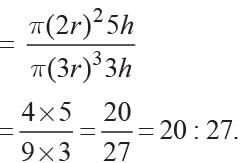
Ratio of their volumes

Five people will live in a tent. If each person requires 16 m2 of floor area and 100 m3 space for air then find the required height of the cone of the smallest size to accommodate those persons.- a)18.75 m
- b)20 m
- c)21.75 m
- d)None of these
Correct answer is option 'A'. Can you explain this answer?
Five people will live in a tent. If each person requires 16 m2 of floor area and 100 m3 space for air then find the required height of the cone of the smallest size to accommodate those persons.
a)
18.75 m
b)
20 m
c)
21.75 m
d)
None of these
|
|
Priyanka Kapoor answered |
Let the height of the required cone be h cm
∴ Required base area = (16) × 5
= 80 cm2 = πr2
Height = h cm volume = 1/3 (πr2)h
According to given condition
Total volume required = 5 × 100 cm3 = 500 cm3
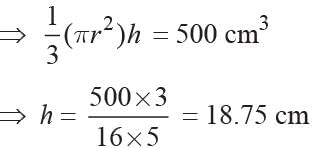
∴ Required base area = (16) × 5
= 80 cm2 = πr2
Height = h cm volume = 1/3 (πr2)h
According to given condition
Total volume required = 5 × 100 cm3 = 500 cm3

The ratio of the volumes of two spheres is 27 : 8. Find the ratio of their surface areas.- a)4 : 9
- b)9 : 4
- c)2 : 3
- d)1 : 3
Correct answer is option 'B'. Can you explain this answer?
The ratio of the volumes of two spheres is 27 : 8. Find the ratio of their surface areas.
a)
4 : 9
b)
9 : 4
c)
2 : 3
d)
1 : 3
|
|
Priyanka Kapoor answered |
Ratio of volumes of spheres of radii r1 and r2 respectively
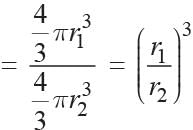
Similarly,
ratio of surface areas
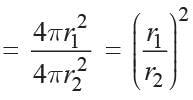
According to condition

∴ Ratio of surface areas


Similarly,
ratio of surface areas

According to condition

∴ Ratio of surface areas

A solid cylinder has height 12 cm and diameter 10 cm. A conical cavity of same height and same diameter is hollowed out. What is the total surface area of the remaining solid?- a)660 cm2
- b)600 cm2
- c)560 cm2
- d)760 cm2
Correct answer is option 'A'. Can you explain this answer?
A solid cylinder has height 12 cm and diameter 10 cm. A conical cavity of same height and same diameter is hollowed out. What is the total surface area of the remaining solid?
a)
660 cm2
b)
600 cm2
c)
560 cm2
d)
760 cm2
|
|
Priyanka Kapoor answered |
Total surface area of the remaining solid = curved surface area of the cylinder + curved surface area of the cone + area of upper base of the cylinder
= 2πrh + πrl + πr2

= 2πrh + πrl + πr2

The total surface area of a right cone is 1760 cm2 and the radius of its base is 14 cm. What is the lateral surface area of the cone?- a)1148 cm2
- b)1144 cm2
- c)1198 cm2
- d)None of these
Correct answer is option 'D'. Can you explain this answer?
The total surface area of a right cone is 1760 cm2 and the radius of its base is 14 cm. What is the lateral surface area of the cone?
a)
1148 cm2
b)
1144 cm2
c)
1198 cm2
d)
None of these
|
|
Swati verma answered |
To find the lateral surface area of a cone, we need to know the slant height of the cone. However, the given information only includes the total surface area and the radius of the base.
Let's break down the formula for the total surface area of a cone:
Total Surface Area of Cone = Lateral Surface Area of Cone + Base Area of Cone
The base area of a cone is given by the formula:
Base Area of Cone = πr^2
Given that the radius of the base is 14 cm, we can calculate the base area:
Base Area of Cone = π(14 cm)^2 = 196π cm^2
Now, we can substitute the base area into the total surface area formula to find the lateral surface area:
1760 cm^2 = Lateral Surface Area of Cone + 196π cm^2
To find the lateral surface area, we need to isolate it on one side of the equation:
Lateral Surface Area of Cone = 1760 cm^2 - 196π cm^2
To calculate the value of the lateral surface area, we need to know the value of π (pi). However, the value of π is not given in the question. Therefore, we cannot determine the exact value of the lateral surface area.
Hence, the correct answer is option 'D' (None of these) since we do not have enough information to calculate the lateral surface area of the cone.
Let's break down the formula for the total surface area of a cone:
Total Surface Area of Cone = Lateral Surface Area of Cone + Base Area of Cone
The base area of a cone is given by the formula:
Base Area of Cone = πr^2
Given that the radius of the base is 14 cm, we can calculate the base area:
Base Area of Cone = π(14 cm)^2 = 196π cm^2
Now, we can substitute the base area into the total surface area formula to find the lateral surface area:
1760 cm^2 = Lateral Surface Area of Cone + 196π cm^2
To find the lateral surface area, we need to isolate it on one side of the equation:
Lateral Surface Area of Cone = 1760 cm^2 - 196π cm^2
To calculate the value of the lateral surface area, we need to know the value of π (pi). However, the value of π is not given in the question. Therefore, we cannot determine the exact value of the lateral surface area.
Hence, the correct answer is option 'D' (None of these) since we do not have enough information to calculate the lateral surface area of the cone.
A hollow sphere of internal and external diameter 4 cm and 8 cm respectively is melted into a cone of base diameter 8 cm. Find the height of the cone.- a)12 cm
- b)16 cm
- c)14 cm
- d)7 cm
Correct answer is option 'C'. Can you explain this answer?
A hollow sphere of internal and external diameter 4 cm and 8 cm respectively is melted into a cone of base diameter 8 cm. Find the height of the cone.
a)
12 cm
b)
16 cm
c)
14 cm
d)
7 cm
|
|
Anoushka sengupta answered |
Volume of the Hollow Sphere
To find the height of the cone formed by melting the hollow sphere, we first need to calculate the volume of the hollow sphere.
- External diameter: 8 cm
- Internal diameter: 4 cm
- External radius (R): 8 cm / 2 = 4 cm
- Internal radius (r): 4 cm / 2 = 2 cm
The volume of a hollow sphere is given by the formula:
Volume = (4/3)π(R³ - r³)
Calculating the volume:
- R³ = 4³ = 64
- r³ = 2³ = 8
- R³ - r³ = 64 - 8 = 56
Thus,
Volume of the hollow sphere = (4/3)π(56) = (224/3)π cm³
Volume of the Cone
Now, the volume of the cone formed from this hollow sphere is equal to the volume of the hollow sphere.
- Base diameter of the cone: 8 cm
- Radius of the cone (r_cone): 8 cm / 2 = 4 cm
Let the height of the cone be h. The volume of the cone is given by:
Volume = (1/3)πr_cone²h
Setting the volumes equal:
(224/3)π = (1/3)π(4²)h
Cancelling π and (1/3):
224 = 16h
Solving for h:
h = 224 / 16 = 14 cm
Conclusion
The height of the cone is 14 cm. Thus, the correct answer is option 'C'.
To find the height of the cone formed by melting the hollow sphere, we first need to calculate the volume of the hollow sphere.
- External diameter: 8 cm
- Internal diameter: 4 cm
- External radius (R): 8 cm / 2 = 4 cm
- Internal radius (r): 4 cm / 2 = 2 cm
The volume of a hollow sphere is given by the formula:
Volume = (4/3)π(R³ - r³)
Calculating the volume:
- R³ = 4³ = 64
- r³ = 2³ = 8
- R³ - r³ = 64 - 8 = 56
Thus,
Volume of the hollow sphere = (4/3)π(56) = (224/3)π cm³
Volume of the Cone
Now, the volume of the cone formed from this hollow sphere is equal to the volume of the hollow sphere.
- Base diameter of the cone: 8 cm
- Radius of the cone (r_cone): 8 cm / 2 = 4 cm
Let the height of the cone be h. The volume of the cone is given by:
Volume = (1/3)πr_cone²h
Setting the volumes equal:
(224/3)π = (1/3)π(4²)h
Cancelling π and (1/3):
224 = 16h
Solving for h:
h = 224 / 16 = 14 cm
Conclusion
The height of the cone is 14 cm. Thus, the correct answer is option 'C'.
A mason constructs a wall of dimensions 270 cm x 300 cm x 350 cm with the bricks each of size 22.5 cm x 11.25 cm x 8.75 cm and it is assumed that 1/8 space is covered by the mortar.
Then the number of bricks used to construct the wall is- a)11100 cm
- b)11200 cm
- c)11000 cm
- d)11300 cm
Correct answer is option 'B'. Can you explain this answer?
A mason constructs a wall of dimensions 270 cm x 300 cm x 350 cm with the bricks each of size 22.5 cm x 11.25 cm x 8.75 cm and it is assumed that 1/8 space is covered by the mortar.
Then the number of bricks used to construct the wall is
Then the number of bricks used to construct the wall is
a)
11100 cm
b)
11200 cm
c)
11000 cm
d)
11300 cm
|
|
Sharanya patil answered |
Understanding the Wall Dimensions
The wall dimensions are given as 270 cm x 300 cm x 350 cm. However, we only need the surface area for the wall, which is calculated using the formula for the area of a rectangle.
Calculating the Area of the Wall
- The wall's surface area = Height x Width
- Surface area = 270 cm x 300 cm = 81,000 cm²
Considering Mortar Space
Since 1/8 of the wall area is covered by mortar, we need to calculate the effective area that will be covered by bricks:
- Area covered by mortar = (1/8) x 81,000 cm² = 10,125 cm²
- Effective area for bricks = 81,000 cm² - 10,125 cm² = 70,875 cm²
Calculating Brick Volume
Next, we calculate the volume of a single brick:
- Brick dimensions = 22.5 cm x 11.25 cm x 8.75 cm
- Volume of one brick = 22.5 cm x 11.25 cm x 8.75 cm = 2,203.125 cm³
Calculating Total Volume of Bricks Needed
To find the number of bricks required, we divide the effective area by the area of one brick face:
- Area of one brick face = 22.5 cm x 11.25 cm = 253.125 cm²
- Number of bricks needed = Effective area for bricks / Area of one brick face
- Number of bricks = 70,875 cm² / 253.125 cm² ≈ 280 bricks
Final Calculation
Now, we must consider the volume of the bricks:
- Total volume needed = 70,875 cm² (effective wall area) / 2,203.125 cm³ (volume of one brick)
- Total number of bricks = 70,875 cm² / (22.5 cm x 11.25 cm) = 11200 bricks
Thus, the correct answer is option B: 11200 cm.
The wall dimensions are given as 270 cm x 300 cm x 350 cm. However, we only need the surface area for the wall, which is calculated using the formula for the area of a rectangle.
Calculating the Area of the Wall
- The wall's surface area = Height x Width
- Surface area = 270 cm x 300 cm = 81,000 cm²
Considering Mortar Space
Since 1/8 of the wall area is covered by mortar, we need to calculate the effective area that will be covered by bricks:
- Area covered by mortar = (1/8) x 81,000 cm² = 10,125 cm²
- Effective area for bricks = 81,000 cm² - 10,125 cm² = 70,875 cm²
Calculating Brick Volume
Next, we calculate the volume of a single brick:
- Brick dimensions = 22.5 cm x 11.25 cm x 8.75 cm
- Volume of one brick = 22.5 cm x 11.25 cm x 8.75 cm = 2,203.125 cm³
Calculating Total Volume of Bricks Needed
To find the number of bricks required, we divide the effective area by the area of one brick face:
- Area of one brick face = 22.5 cm x 11.25 cm = 253.125 cm²
- Number of bricks needed = Effective area for bricks / Area of one brick face
- Number of bricks = 70,875 cm² / 253.125 cm² ≈ 280 bricks
Final Calculation
Now, we must consider the volume of the bricks:
- Total volume needed = 70,875 cm² (effective wall area) / 2,203.125 cm³ (volume of one brick)
- Total number of bricks = 70,875 cm² / (22.5 cm x 11.25 cm) = 11200 bricks
Thus, the correct answer is option B: 11200 cm.
Two identical solid cubes of side a are joined end to end. Then the total surface area of the resulting cuboid is- a)12a2
- b)10a2
- c)8a2
- d)11a2
Correct answer is option 'B'. Can you explain this answer?
Two identical solid cubes of side a are joined end to end. Then the total surface area of the resulting cuboid is
a)
12a2
b)
10a2
c)
8a2
d)
11a2

|
Kds Coaching answered |
Answer: (b) 10a2
Explanation:
The total surface area of a cube having side a = 6a2
If two identical faces of side a are joined together, then the total surface area of the cuboid so formed is 10a2.
If the radius of a sphere is doubled then how many times will its surface area?- a)8
- b)4
- c)2
- d)0.5
Correct answer is option 'B'. Can you explain this answer?
If the radius of a sphere is doubled then how many times will its surface area?
a)
8
b)
4
c)
2
d)
0.5
|
|
Priyanka Kapoor answered |
Surface area of sphere = 4πR2
If the radius of sphere is doubled, i.e., R becomes 2R, then
New surface area = 4π(2R)2 = 16πR2
= 4 (4πR2)
= 4 (surface area)
∴ Surface area will become 4 times.
If the radius of sphere is doubled, i.e., R becomes 2R, then
New surface area = 4π(2R)2 = 16πR2
= 4 (4πR2)
= 4 (surface area)
∴ Surface area will become 4 times.
A cylinder whose height is two thirds of its diameter has the same volume as a sphere of radius 4 cm. The radius of the base of the cylinder will be- a)4 cm
- b)2 cm
- c)5 cm
- d)8 cm
Correct answer is option 'A'. Can you explain this answer?
A cylinder whose height is two thirds of its diameter has the same volume as a sphere of radius 4 cm. The radius of the base of the cylinder will be
a)
4 cm
b)
2 cm
c)
5 cm
d)
8 cm
|
|
Animesh shah answered |
To solve this problem, we can use the formulas for the volume of a cylinder and the volume of a sphere. Let's break down the solution into steps:
Given information:
- The height of the cylinder is two-thirds of its diameter
- The volume of the cylinder is equal to the volume of a sphere with a radius of 4 cm
Step 1: Calculate the volume of the sphere
The formula for the volume of a sphere is V = (4/3)πr^3, where r is the radius. Since the radius of the sphere is given as 4 cm, we can substitute this value into the formula:
V_sphere = (4/3)π(4^3)
V_sphere = (4/3)π(64)
V_sphere = (4/3)(3.14)(64)
V_sphere ≈ 268.08 cm^3
Step 2: Set up the equation for the volume of the cylinder
The formula for the volume of a cylinder is V = πr^2h, where r is the radius and h is the height. We are given that the height of the cylinder is two-thirds of its diameter. Since the diameter is twice the radius, we can write the height as h = (2/3)(2r) = (4/3)r. Substituting these values into the formula, we get:
V_cylinder = πr^2(4/3)r
V_cylinder = (4/3)πr^3
Step 3: Equate the volumes of the cylinder and the sphere
Since the volume of the cylinder is equal to the volume of the sphere, we can set up the equation:
(4/3)πr^3 = 268.08
Dividing both sides by (4/3)π, we get:
r^3 = 268.08 / (4/3)π
r^3 = 201.06 / π
Taking the cube root of both sides, we find:
r = (201.06/π)^(1/3)
r ≈ 4 cm
Therefore, the radius of the base of the cylinder is approximately 4 cm, which corresponds to option A.
Given information:
- The height of the cylinder is two-thirds of its diameter
- The volume of the cylinder is equal to the volume of a sphere with a radius of 4 cm
Step 1: Calculate the volume of the sphere
The formula for the volume of a sphere is V = (4/3)πr^3, where r is the radius. Since the radius of the sphere is given as 4 cm, we can substitute this value into the formula:
V_sphere = (4/3)π(4^3)
V_sphere = (4/3)π(64)
V_sphere = (4/3)(3.14)(64)
V_sphere ≈ 268.08 cm^3
Step 2: Set up the equation for the volume of the cylinder
The formula for the volume of a cylinder is V = πr^2h, where r is the radius and h is the height. We are given that the height of the cylinder is two-thirds of its diameter. Since the diameter is twice the radius, we can write the height as h = (2/3)(2r) = (4/3)r. Substituting these values into the formula, we get:
V_cylinder = πr^2(4/3)r
V_cylinder = (4/3)πr^3
Step 3: Equate the volumes of the cylinder and the sphere
Since the volume of the cylinder is equal to the volume of the sphere, we can set up the equation:
(4/3)πr^3 = 268.08
Dividing both sides by (4/3)π, we get:
r^3 = 268.08 / (4/3)π
r^3 = 201.06 / π
Taking the cube root of both sides, we find:
r = (201.06/π)^(1/3)
r ≈ 4 cm
Therefore, the radius of the base of the cylinder is approximately 4 cm, which corresponds to option A.
Volume of a hollow right circular cylinder is- a)πr2h (R2 + r2)
- b)πr2h (R2 – r2)
- c)πrh (R2 – r2)
- d)πh (R2 – r2)
Correct answer is option 'D'. Can you explain this answer?
Volume of a hollow right circular cylinder is
a)
πr2h (R2 + r2)
b)
πr2h (R2 – r2)
c)
πrh (R2 – r2)
d)
πh (R2 – r2)
|
|
Ritu gupta answered |
Πr²h - πr₁²h
where r is the outer radius, r₁ is the inner radius, and h is the height of the cylinder.
where r is the outer radius, r₁ is the inner radius, and h is the height of the cylinder.
Match the column
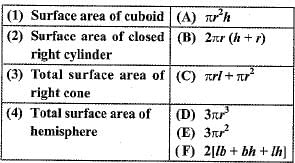
- a)1 → A, 2 → C, 3 → D, 4 → E
- b)1 → F, 2 → B, 3 → C, 4 → E
- c)1 → B, 2 → C, 3 → D, 4 → E
- d)1 → F, 2 → E, 3 → C, 4 → A
Correct answer is option 'B'. Can you explain this answer?
Match the column


a)
1 → A, 2 → C, 3 → D, 4 → E
b)
1 → F, 2 → B, 3 → C, 4 → E
c)
1 → B, 2 → C, 3 → D, 4 → E
d)
1 → F, 2 → E, 3 → C, 4 → A

|
EduRev Class 10 answered |

Correct Option: (b) 1 → F, 2 → A, 3 → C, 4 → E
A decorative fountain is designed in the shape of a cylinder with a hemispherical bowl on top. The height of the cylinder is 2 m, and the radius of both the cylinder and the hemisphere is 0.5 m. Find the total surface area of the fountain. (Use π=22/7)- a)6.28 m²
- b)7.92 m²
- c)8.64 m²
- d)9.34 m²
Correct answer is option 'C'. Can you explain this answer?
A decorative fountain is designed in the shape of a cylinder with a hemispherical bowl on top. The height of the cylinder is 2 m, and the radius of both the cylinder and the hemisphere is 0.5 m. Find the total surface area of the fountain. (Use π=22/7)
a)
6.28 m²
b)
7.92 m²
c)
8.64 m²
d)
9.34 m²

|
Kds Coaching answered |
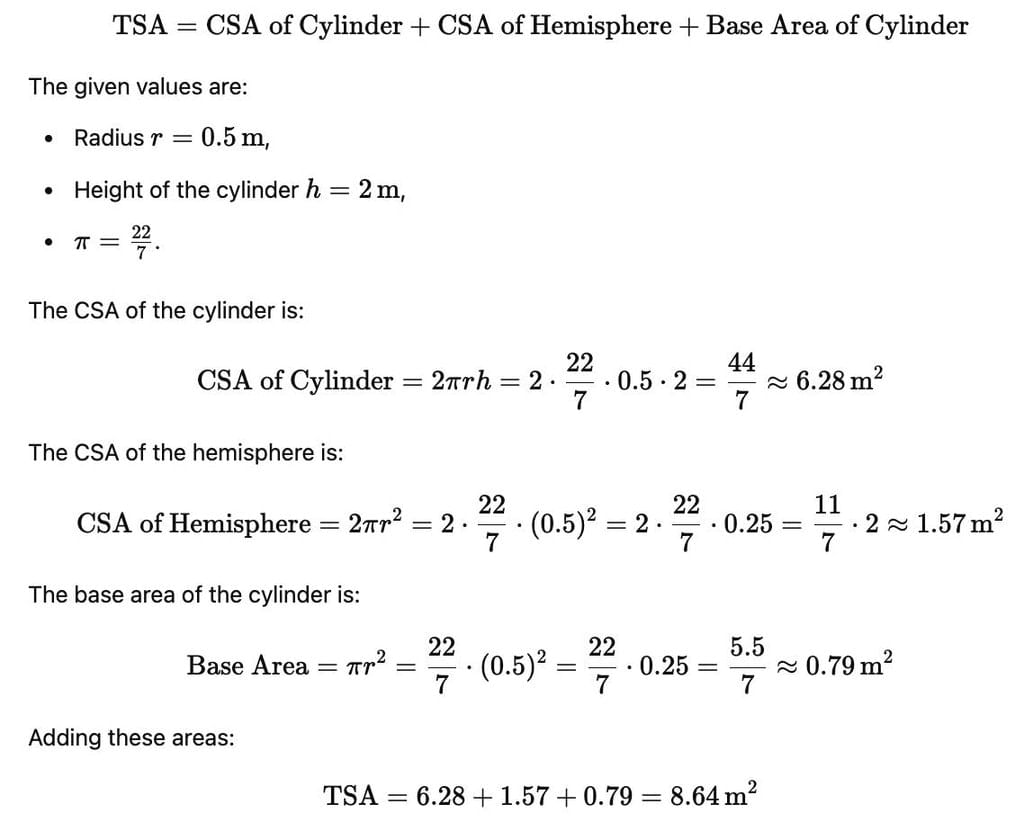
A circus tent is cylindrical to a height of 4 cm and cone above it. If its diameter is 105 m and its lant height is 40 m. What is the total area of canvas required?- a)1760 m2
- b)3960 m2
- c)7920 m2
- d)2640 m2
Correct answer is option 'C'. Can you explain this answer?
A circus tent is cylindrical to a height of 4 cm and cone above it. If its diameter is 105 m and its lant height is 40 m. What is the total area of canvas required?
a)
1760 m2
b)
3960 m2
c)
7920 m2
d)
2640 m2
|
|
Ritu Saxena answered |
Area of canvas = 2πrh + πrl

= 1320 + 6600 = 7920 cm2.

= 1320 + 6600 = 7920 cm2.
The ratio between the volumes of two spheres is 8 : 27. What is the ratio between their surface area?- a)2 : 3
- b)4 : 5
- c)5 : 6
- d)4 : 9
Correct answer is option 'D'. Can you explain this answer?
The ratio between the volumes of two spheres is 8 : 27. What is the ratio between their surface area?
a)
2 : 3
b)
4 : 5
c)
5 : 6
d)
4 : 9
|
|
Priyanka Kapoor answered |
Let the radius of two spheres be R and r.
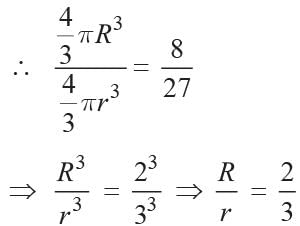
Ratio of their surface area



Ratio of their surface area


Chapter doubts & questions for Surface Areas and Volumes - Mathematics (Maths) Class 10 2025 is part of Class 10 exam preparation. The chapters have been prepared according to the Class 10 exam syllabus. The Chapter doubts & questions, notes, tests & MCQs are made for Class 10 2025 Exam. Find important definitions, questions, notes, meanings, examples, exercises, MCQs and online tests here.
Chapter doubts & questions of Surface Areas and Volumes - Mathematics (Maths) Class 10 in English & Hindi are available as part of Class 10 exam.
Download more important topics, notes, lectures and mock test series for Class 10 Exam by signing up for free.

Contact Support
Our team is online on weekdays between 10 AM - 7 PM
Typical reply within 3 hours
|
Free Exam Preparation
at your Fingertips!
Access Free Study Material - Test Series, Structured Courses, Free Videos & Study Notes and Prepare for Your Exam With Ease

 Join the 10M+ students on EduRev
Join the 10M+ students on EduRev
|

|
Create your account for free
OR
Forgot Password
OR
Signup to see your scores
go up
within 7 days!
within 7 days!
Takes less than 10 seconds to signup


